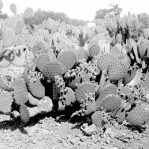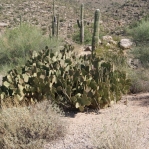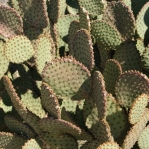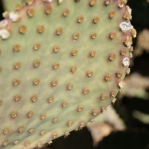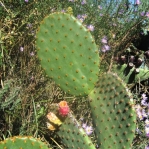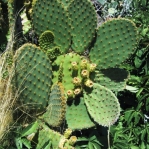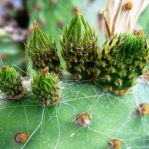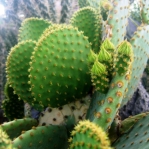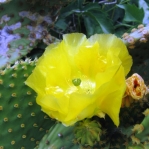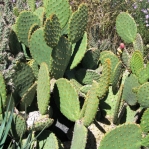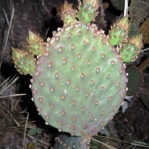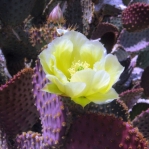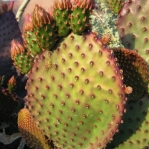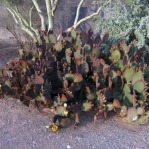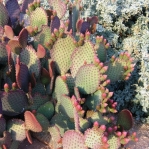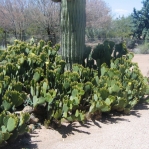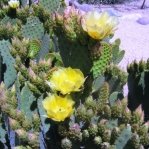
Griffiths, Annual Report of the Missouri Botanical Garden 21: 169, 1910
Herbarium; Drawing (Britton and Rose, v1 1919, fig 174); Painting; Painting
Original Citation
What is Opuntia lubrica?
Opuntia lubrica is a prickly pear cactus that has some similarity to O. rufida. However, O. lubrica has shiny pads that are not pubescent as in the other cactus.
Details
Plants often have the habit of O. microdasys and may be 0.5-1 m tall. Cladodes of the current year may be nearly circular or obovate and 15 cm inches wide by approximately 20 cm long. This prickly pear has tight, dense clumps of prominent but short glochids (4-5 mm), yellow to dark rust red, in a crescent adaxially. Glochids can increase in number and length on older stems and may eventually populate the entirety of areoles rather than remaining in a crescent. Sometimes there are a few spines or many (same color as the glochids), but often the plants are spineless. If spines are present they can increase with age to over a dozen per areole. Spines may be 12 mm long or longer. Areole tissue may proliferate and glochids may increase over time creating prominent tufts of glochids on older cladodes.
The flowers are bright yellow, typically a little greenish in the center, sometimes developing a brassy or slightly orange hue as they age. Fruit is often bright red with a green rind and red pulp. Fruit is acid and juicy with lots of areoles and short glochids (much like those of O. rufida and O. microdasys, but larger). Seeds are small, about 3 mm across.
Ploidy is unknown.
Other Notes
O. lubrica may have hybrid origins, and possibly the plants in Arizona are not closely related to the ones in eastern Mexico. However, they all look related to one another. It is possible (but not at all demonstrated) that the plants in San Luis Potosi may be derived from O. cacanapa × O. microdasys. In Coahuila they might be derived from O. cacanapa × O. rufida. In Arizona they might be O. chlorotica santa-rita × O. microdasys. These suppositions are not demonstrated and perhaps all 3 populations constitute a single species with a common origin. Also, if O. cacanapa or O. chlorotica santa-rita are proposed parental taxa, why is O. lubrica so small?
In Mexico the authors have mostly seen the plants on rocky slopes east of, or in the eastern part of, the Chihuahuan Desert, usually not in stark desert conditions (in the same areas that O. cacanapa favors). In Mexico, no plant has been observed with purplish coloring (other than a tiny hint around the areoles when it gets really cold, and only in some plants). O. lubrica grows from at least as far north as the Monclova area and the Sierra de la Paila in Coahuila south into San Luis Potosi. There are never large colonies, just scattered individuals.

